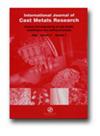Surface modification of ductile iron produced by an innovative in-situ casting technique
IF 1.1
4区 材料科学
Q3 METALLURGY & METALLURGICAL ENGINEERING
International Journal of Cast Metals Research
Pub Date : 2020-05-03
DOI:10.1080/13640461.2020.1766278
引用次数: 3
Abstract
ABSTRACT In this study, a chromium carbide layer was fabricated by an in-situ casting technique on ductile iron cast components. The procedure consists of (i) applying a ferrochrome slurry at the surfaces of silica sand moulds to create a surface layer (e.g. coating) and (ii) use a ductile iron alloy to cast the coated moulds. The microstructure of the realised surface layer was characterised and analysed via Scanning Electron Microscopy (SEM), optical microscopy (OM) and X-ray Diffraction (XRD).The corrosion behaviour of the samples was analysed by an electrochemical method using 0.03 M NaCl. The wear tests and Vickers hardness measurements were performed to determine the properties of the surface layer. It was determined that the layer is composed of chromium carbide (Cr7C3), ledeburite and pearlite. The ‘chromium carbide’constituent improved significantly both the wear resistance and the hardness of the surface layer. Electrochemical measurements have indicated that the carbide-based layer exhibits a lower corrosion resistance than the substrate (e.g. casting).采用创新原位铸造技术生产球墨铸铁的表面改性
采用原位铸造技术在球墨铸铁件表面制备碳化铬层。该过程包括(i)在硅砂模具表面涂上铬铁浆料以形成表面层(例如涂层)和(ii)使用球墨铁合金铸造涂层模具。通过扫描电子显微镜(SEM)、光学显微镜(OM)和x射线衍射仪(XRD)对实现的面层微观结构进行了表征和分析。用电化学方法分析了样品在0.03 M NaCl溶液中的腐蚀行为。进行了磨损试验和维氏硬度测量,以确定表面层的性能。测定该层由碳化铬(Cr7C3)、莱氏体和珠光体组成。碳化铬成分显著提高了合金的耐磨性和表层硬度。电化学测量表明,碳化物基层的耐腐蚀性低于基材(如铸件)。
本文章由计算机程序翻译,如有差异,请以英文原文为准。
求助全文
约1分钟内获得全文
求助全文
来源期刊
CiteScore
2.70
自引率
7.10%
发文量
14
审稿时长
7.5 months
期刊介绍:
The International Journal of Cast Metals Research is devoted to the dissemination of peer reviewed information on the science and engineering of cast metals, solidification and casting processes. Assured production of high integrity castings requires an integrated approach that optimises casting, mould and gating design; mould materials and binders; alloy composition and microstructure; metal melting, modification and handling; dimensional control; and finishing and post-treatment of the casting. The Journal reports advances in both the fundamental science and materials and production engineering contributing to the successful manufacture of fit for purpose castings.

 求助内容:
求助内容: 应助结果提醒方式:
应助结果提醒方式:


